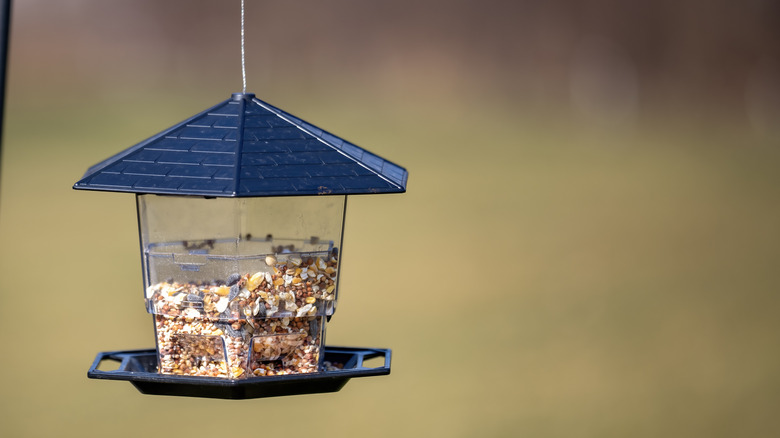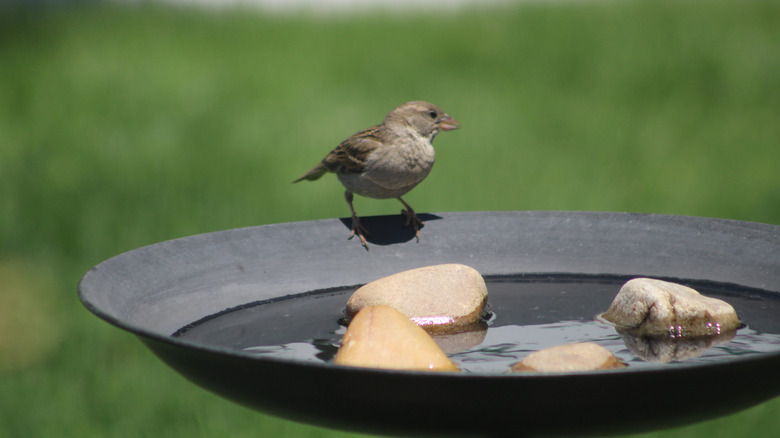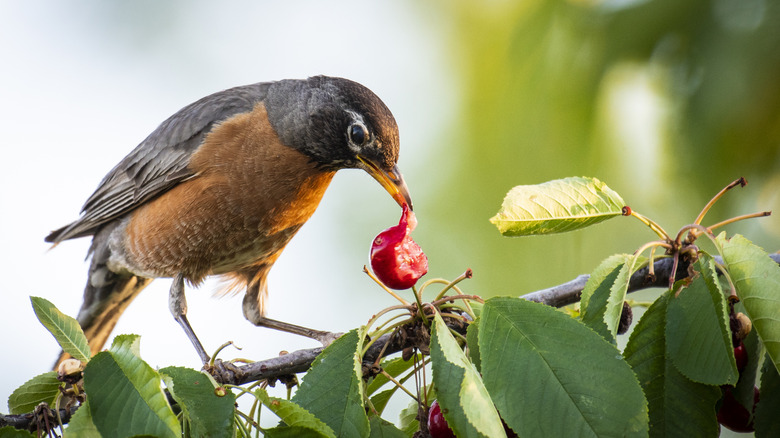Have A Bird Feeder But No Birds? You May Be Missing A Crucial Step
Modern life can make it hard to stay present sometimes — but there's nothing like the sight of birds flocking to your yard to make you stop everything you're doing and bask in nature's beauty. If you've installed a bird feeder and still aren't seeing any birds, don't give up. Food is great, but some birds need something even more enticing to give your yard a try: water.
The fact is, feeders only make up one small part of a bird's diet. They're constantly looking for food elsewhere, and during some years and seasons, nature's supply is abundant enough that you're likely to see fewer birds at your feeders. Some birds are unlikely to visit feeders at all, such as robins, phoebes, mockingbirds, wrens, and waxwings.
Water, on the other hand, is a precious resource that is even more difficult than food for birds to reliably locate. So, if the birdseed isn't quite doing the trick, water is the most logical next option. The best way to tempt more visitors is to turn your yard into a bird-friendly haven, providing all of the essentials that they need to survive. Adding water is a key part of that.
Designing the ideal bird bath
Birds need fresh water to stay hydrated. But they also use it for bathing and regulating their temperature in hot weather. Especially if you live in an urban area, it can be tough for birds to find a reliable source of clean water in a location that's safe from predators. While a bird feeder will only attract specific species based on its food and shape, a well-designed bath will attract all types of birds, even those that rarely ever come to feeders. Birdbaths are especially likely to attract birds during migration season in the spring and fall.
What does a well-designed bird bath look like? Rather than the traditional concrete bird bath sold in many garden stores, opt for a shallower bath with a slight slope to it — around 2 inches deep in the center and 1 inch deep on the edges. This shape mimics the puddles that birds instinctively look for in nature. Place the bath on or near the ground in the shade, and add a few flat stones that the birds can perch on to drink without getting wet.
Adding some type of movement to the bath is also key. For whatever reason, birds are drawn to the sight and sound of moving water. Running water, such as in a fountain, is one option, but you can also add a fine mist or spray (make sure to buy one designed for bird baths). There are even devices called "water wigglers" that you can place in the bath to add vibration and movement. Moving water can attract additional species that don't normally visit bird baths like ruby-throated hummingbirds.
Other ways to attract more birds
Just adding a bird bath isn't enough — don't forget to regularly clean it. Not only will clean water attract the most birds, but it is vital for keeping them safe and preventing disease. Change the water every one to two days.
There are other ways to turn your yard into a bird's paradise. Adding nesting materials will attract more birds, especially during nesting season. Planting more native plants can provide natural food sources that birds hunt for (like insects, fruits, and seeds), as well as shelter and nesting areas. Between fresh food, clean water, and shelter, what else could a bird want?
You might also be making other mistakes with your bird feeder that could explain a lack of birds. Make sure you're providing the right types of food for the birds you want to attract — bluebirds enjoy mealworms, hummingbirds love nectar, and lots of different birds will feast on sunflower seeds, for example. Skip the mixed bird seed since it often contains filler ingredients that birds don't eat (and pests do). You may also need to rethink the type of feeder and the location, comparing it to the habits of the birds you want to attract. Do they tend to feed on the ground or up high? The wrong location can leave your bird feeder overrun by squirrels, which will scare off the birds. You can keep squirrels away from your bird feeder by mounting the feeder on a pole away from trees and adding a squirrel baffle to the base. Keep the feeder as clean and neat as possible.


